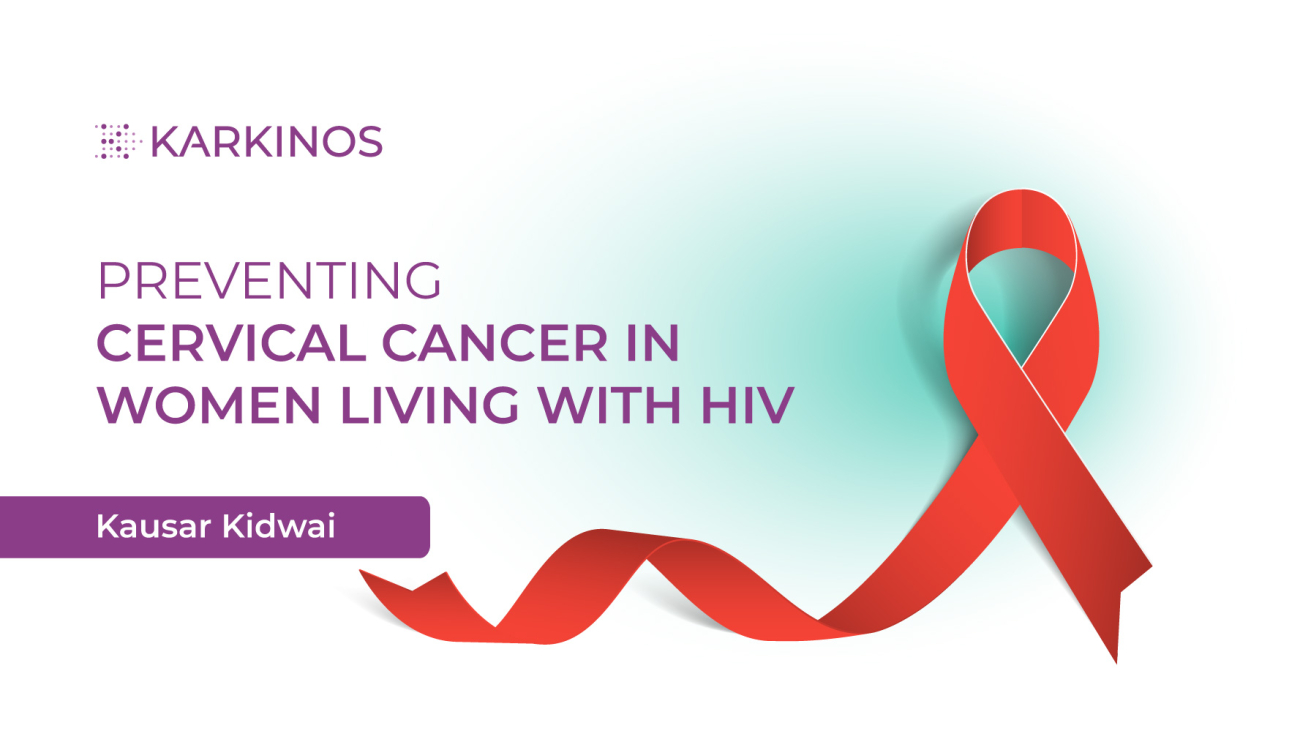Transformative Initiatives: Combating Cervical Cancer Among WLHIV in India’s Heartland
By Kausar Kidwai, Assistant Vice President, Women Wellness, Karkinos Healthcare
Lata, presently undergoing treatment at the Mahatma Gandhi Memorial Medical College (MGMMC) in Indore for cervical cancer, embodies resilience and the indomitable human spirit. Her journey from adversity to triumph serves as a beacon of hope, illustrating that even amidst the darkest shadows, resilience and courage make life worth living.
Dr. Sumitra Yadav, HOD of Gynaecology at MGMMC, Indore, left no stone unturned in making this possible. “Lata showed no symptoms with stage 3 disease. It could have taken her life, but high-precision screening with HPV DNA testing is a game-changer. It’s a testament to the power of early detection; it was a life-saving intervention,” says Dr. Yadav.
According to Globocan 2022, an annual mortality rate exceeding 900,000 and an incidence of over 1.4 million cases, cancer has swiftly become a leading cause of mortality and morbidity in India.
Cervical cancer stands as the second most prevalent cancer type among females in the country, alongside breast and oral cancers.
Notably, India contributes to 23% of global cervical cancer deaths. Projections from GLOBOCAN 2022 anticipate a further increase of 54% in incidence and 61% in mortality by 2040. Human Papillomavirus (HPV) infection serves as a fundamental precursor to cervical cancer and precancerous cervical lesions. Available evidence suggests that more than 85% of sexually active individuals will contract some form of HPV during their lifetime, with 90% of infections typically clearing within two years. However, persistent exposure and incidence significantly elevates the risk of cervical cancer.
Women Living with HIV – The Vulnerable Cohort
Women living with HIV (WLHIV) face a significantly elevated risk of developing cervical cancer compared to those not infected with HIV. WLHIV are six times more likely to develop cervical cancer, with an estimated 5% of all cervical cancer cases attributed to HIV. This heightened risk stems from WLHIV being more prone to acquiring Human Papillomavirus (HPV) infections, which are less likely to clear due to compromised immune systems, leading to persistent HPV infections. Moreover, the progression from HPV infection to cervical cancer is expedited in WLHIV, taking approximately 5–10 years as opposed to the typical 15–20 years in HIV-negative individuals.
HIV infection is also associated with more extensive cervical lesions, which are 3–5 times more prevalent in WLHIV than in those without HIV. Countries with high HIV prevalence and limited cervical cancer screening programs consequently, experience higher incidence rates of cervical cancer. In such regions, up to 75% of cervical cancer cases are attributable to HIV.
Therefore, it is crucial to prioritize cervical cancer screening for high-prevalence disease groups like WLHIV, particularly in countries like India with a significant HIV burden. India ranks third globally in terms of HIV burden, and the added burden of HIV-attributable cervical cancer compounds the existing challenges associated with cervical cancer prevention and control.
Current Policy and Programmes
The National Programme for Prevention and Control of Cancer, Diabetes, Cardiovascular Diseases, and Stroke (NPCDCS) in India integrates cervical cancer screening as a vital component, using Visual Inspection with Acetic Acid (VIA) for women aged 30-65 to detect precancerous lesions and early
cancers, enhancing health outcomes. NPCDCS emphasises healthcare provider training and awareness campaigns to promote regular screening, bridging rural-urban healthcare disparities.
Globally, the WHO Global Strategy targets 90% HPV vaccination coverage among girls by age 15 and screening 70% of eligible women aged 35-45, aiming to eliminate cervical cancer as a public health issue.
Gaps and Challenges
Despite efforts, cervical cancer screening coverage remains low in India, with fewer than 1 in 10 women ever screened. In South India, only about 32% of women attending awareness camps agreed to screening, revealing a significant participation challenge. Factors contributing to low uptake include low awareness, fear of screening, privacy concerns, lack of spousal support, stigma, and perceived high costs.
Health workers’ attitudes also affect participation. Consequently, a study estimated that 86.2% of potential cervical intraepithelial neoplasia (CIN2+) cases were missed. Addressing these challenges through awareness campaigns, barrier reduction, community engagement, and supportive environments is crucial to improving screening uptake and reducing cervical cancer burden.
India takes bold steps to fight against Cervical Cancer
Launch of Madhya Pradesh Integrated Model for Cancer Care for Women Living with HIV: The Govt of Madhya Pradesh, takes a bold step to combat Cervical Cancer among women, especially among women living with HIV (WLHIV). The Madhya Pradesh State AIDS Control Society (MPSACS) in partnership with the Vishwanath Cancer Care Foundation (VCCF), in collaboration with Karkinos Healthcare supported by CSR funding from Madhya Pradesh Warehousing Corporation, Madhya Pradesh State Electronics Development Corporation Ltd, MPOnline, and HDFC Bank, has successfully launched the Madhya Pradesh Integrated Model (MPIM) for Cancer Care for WLHIV.
MPIM addresses this challenge effectively by expanding the role of its Antiretroviral Therapy (ART) centres for cervical cancer screening. This has not only ensured access to an additional screening for WLHIV alongside their routine care, but has used Digital Solutions–a Risk Assessment (RA) app to generate Ayushman Bharat Health Account (ABHA) IDs, streamlining patient identification and tracking of referred cases to ensure continuity of care.
Supported by high-performing HPV-DNA diagnostic tests with high negative predictive value has enabled the Madhya Pradesh Government to facilitate early identification and treatment of neoplasia, reducing unnecessary interventions.
At Bhopal, Indore, Jabalpur, and Gwalior, more than 2,600 registered patients have undergone HPV testing indicating a significant uptake of screening services. There has also been a remarkable 80% conversion rate from counseling to undergoing screening for either oral examination or breast examination, indicating the effectiveness of counseling services in motivating individuals to access screening.
Surabhi Gupta, IAS, Project Director of MPSACS, expressed a profound sense of pride in supporting this vulnerable group. Early identification of cervical cancer patients has been integral to their initiative. She emphasized upon collaborative initiatives to address the heightened vulnerability of WLHIV to cervical cancer. Through innovative approaches and multisectoral collaboration, SACS aims to eliminate cervical cancer and enhance the overall health and well-being of WLHIV in Madhya Pradesh.
Reducing Economic Burden – India Level: The MPIM programme estimates a potential saving of INR 600 crore and preventing 66,000 deaths through universal screening of WLHIV in India. In Madhya Pradesh alone, screening of 54,000 WLHIV could potentially save INR 14 crore and preserve 1,500 lives.
Primary HPV screening is endorsed by the National Cancer Grid and WHO, offering better risk stratification and cost-effectiveness. VCCF believes that Government intervention, like price capping, can address cost barriers and increase uptake, potentially reducing prices over time.
The programme in a short span of 1 year has reached over 3500 WLHIV registered patients undergoing screening for common cancers like oral, breast, and cervical cancer in 4 districts of Madhya Pradesh – Bhopal, Jabalpur, Gwalior, and Indore.
Commenting about this programme, Dr. Hemant Verma, SMO, ART Plus Centre, Bhopal, said, “This initiative marks a significant step forward in our efforts to combat cervical cancer among WLHIV. By integrating cancer screening into HIV care services and leveraging digital solutions, we aim to enhance patient outcomes and reduce the burden of this disease.”
The Madhya Pradesh Integrated Model for Cancer Care for WLHIV demonstrates India’s commitment to tackling cervical cancer and improving healthcare access for vulnerable populations. With continued support from stakeholders and communities, we are optimistic about the programme’s ability to make a meaningful impact on cancer prevention and control.

 The company aims to significantly enhance access to cancer care services by creating and enabling access to a technology-enabled data driven platform. In a career spanning 15+ years in India and abroad, she has largely addressed the inequities in cancer prevention services for women in India. Whether it was operationalizing preventive oncology at primary healthcare level in India, screening for incarcerated women or women living with HIV (WLHIV), she has enabled systems to ensure early screening and treatment for dysplasia is operational at primary, secondary and tertiary level public sector facilities in multiple states in Central and North India including Madhya Pradesh, Uttar Pradesh, Punjab etc.
The company aims to significantly enhance access to cancer care services by creating and enabling access to a technology-enabled data driven platform. In a career spanning 15+ years in India and abroad, she has largely addressed the inequities in cancer prevention services for women in India. Whether it was operationalizing preventive oncology at primary healthcare level in India, screening for incarcerated women or women living with HIV (WLHIV), she has enabled systems to ensure early screening and treatment for dysplasia is operational at primary, secondary and tertiary level public sector facilities in multiple states in Central and North India including Madhya Pradesh, Uttar Pradesh, Punjab etc.